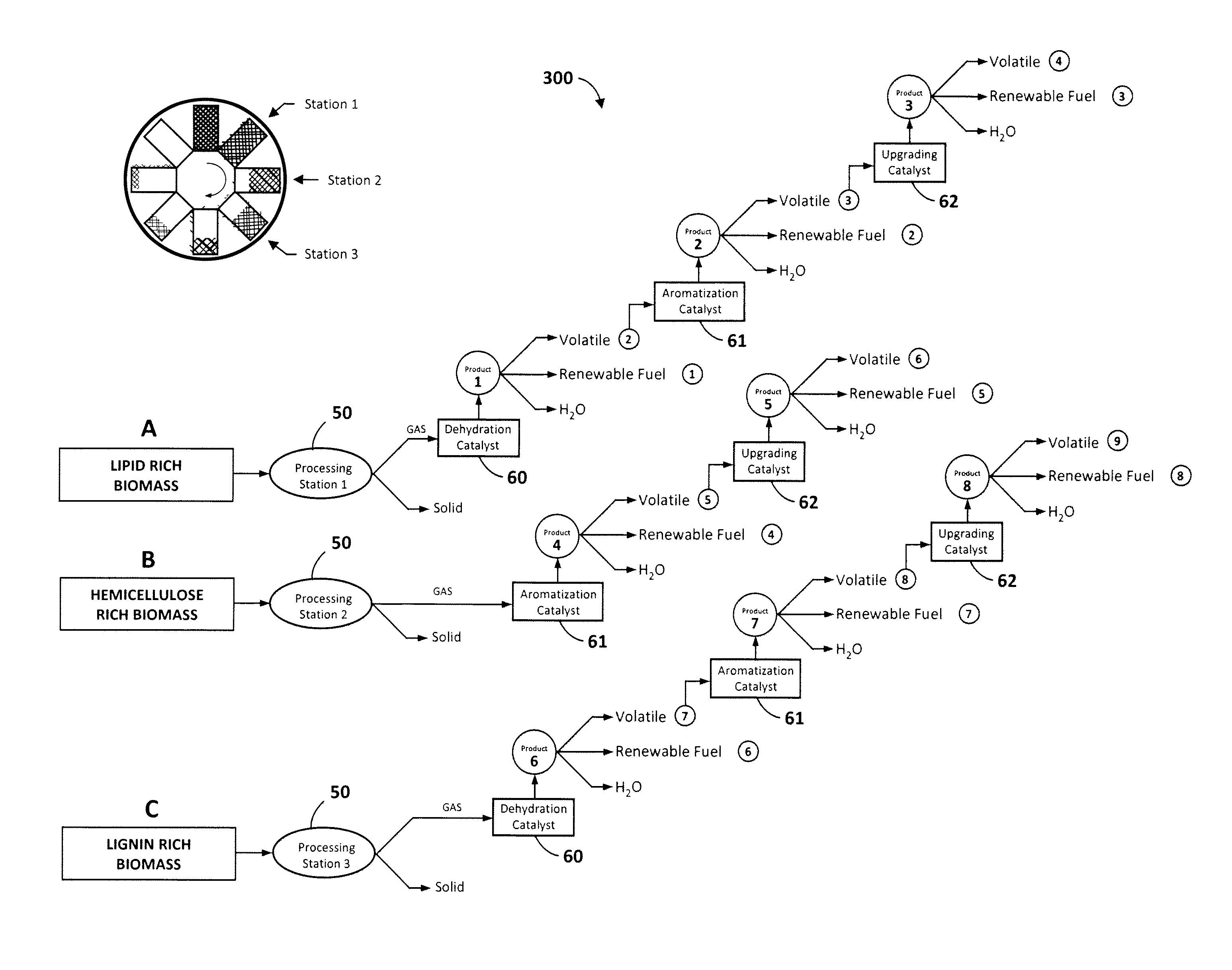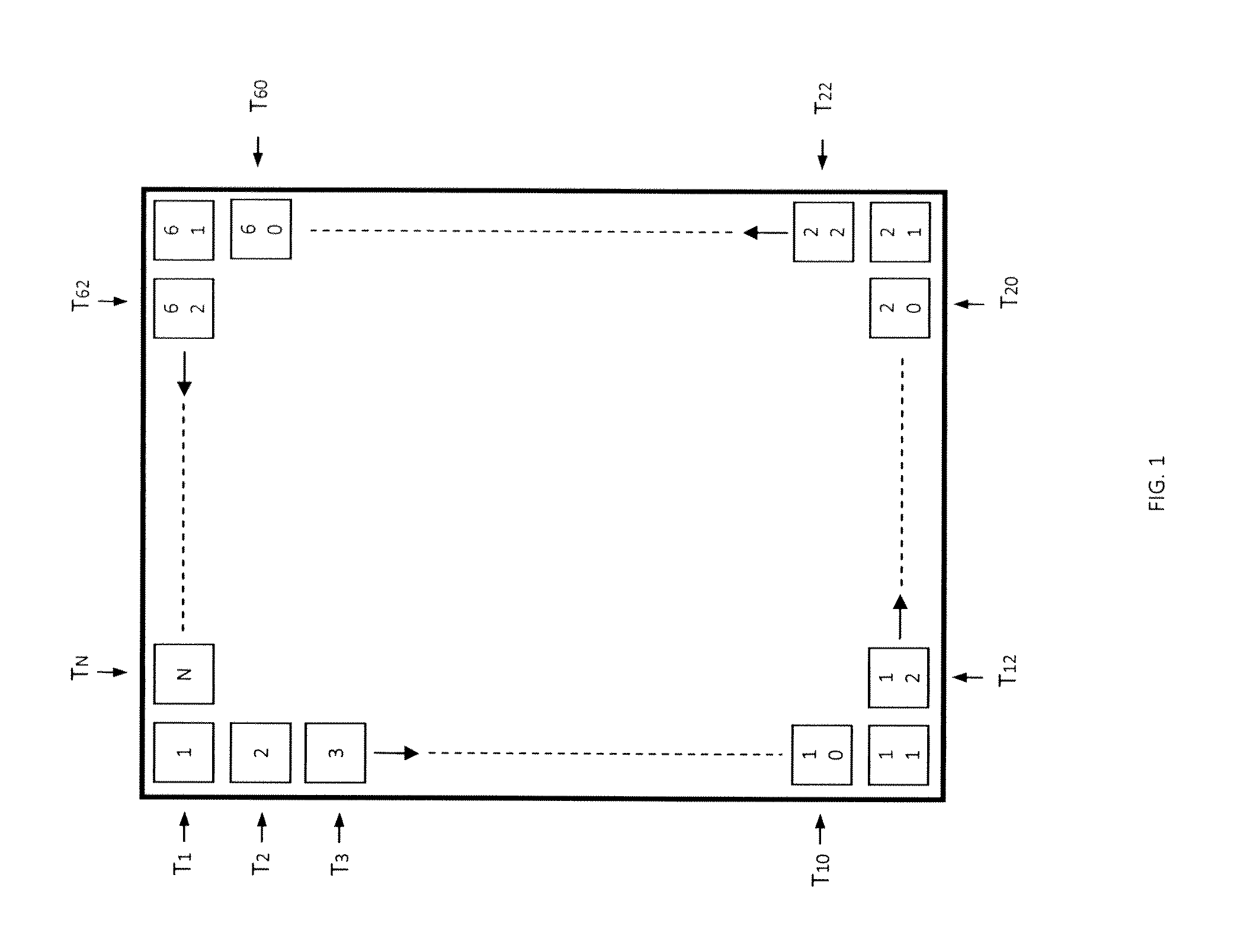System for making renewable fuels
a renewable fuel and fuel technology, applied in the field of renewable fuel systems, can solve the problems of inherently inefficient process, large amount of resultant compounds, and inability to meet the needs of industrial production,
- Summary
- Abstract
- Description
- Claims
- Application Information
AI Technical Summary
Problems solved by technology
Method used
Image
Examples
example 1
Illustrative Example 1
[0047]Referring now to FIG. 6A, this illustrative example is the equivalent to six processing stations 50 operating at six different temperatures wherein the input biomass is fed at 325° C. and the final carbonaceous solid is removed at 575° C. 150 g of biomass consisting of commercial sunflower seeds along with dimethyl ether as co-solvent were devolatilized starting at a temperature of 325° C. and ending at 575° C. with a temperature increment of 50° C. for every hour. 131 g of methanol was passed through a silica alumina catalyst to generate the required co-solvent. The output was passed through three different catalyst columns in series including a dehydration catalyst 60, an aromatization catalyst 61, and a gas-upgrading catalyst 62 as illustrated in FIG. 3 for cut A. More particularly, this experiment employed a silica alumina dehydration catalyst, a Zn and Cr modified ZSM-5 aromatization catalyst, and a Ga modified ZSM-5 gas-upgrading catalyst. FIG. 6A i...
example 2
Illustrative Example 2
[0049]This illustrative example is the equivalent to six processing stations operating at six different temperatures wherein the input biomass is again fed at 325° C. and the final carbonaceous solid is removed at 525° C. 76 g of biomass consisting of commercial corn cobs along with 100 g of methanol were devolatilized starting at a temperature of 325° C. and ending at 525° C. with a temperature increment of 50° C. for every hour. This example assumes that corn cobs contain significant amounts of hemicellulose (C5 sugars), which may decompose in the presence of a dehydration catalyst 60, leading to more breakage of chemical bonds than necessary. Therefore, the output was passed through two different catalyst columns in series, one consisting of an aromatization catalyst 61, followed by a gas-upgrading catalyst 62 as illustrated in FIG. 3 for cut B. In this example, ZSM-5 was employed as the aromatization catalyst, and Ga modified ZSM-5 was employed as the gas-u...
example 3
Illustrative Example 3
[0050]This illustrative example is the equivalent to six processing stations operating at six different temperatures wherein the input biomass is again fed at 325° C. and the final carbonaceous solid is removed at 575° C. 100 g of biomass consisting of red fir wood along with 131 g of methanol were devolatilized starting at a temperature of 325° C. and ending at 575° C. with a temperature increment of 50° C. for every hour. This example assumes that red fir contains significant amounts of lignins which are needed to be decomposed for efficient biomass conversion. The output was passed through two different catalyst columns in series, beginning with the dehydration catalyst 60, and followed by an aromatization catalyst 61. This experiment utilized silica alumina as the dehydration catalyst, and Zn and Cr modified ZSM-5 as the aromatization catalyst. A total of 30.5 ml of renewable fuel was collected by the end of the run from the aromatization catalyst 61, where...
PUM
| Property | Measurement | Unit |
|---|---|---|
| temperature | aaaaa | aaaaa |
| particle size | aaaaa | aaaaa |
| temperature | aaaaa | aaaaa |
Abstract
Description
Claims
Application Information
 Login to View More
Login to View More - R&D
- Intellectual Property
- Life Sciences
- Materials
- Tech Scout
- Unparalleled Data Quality
- Higher Quality Content
- 60% Fewer Hallucinations
Browse by: Latest US Patents, China's latest patents, Technical Efficacy Thesaurus, Application Domain, Technology Topic, Popular Technical Reports.
© 2025 PatSnap. All rights reserved.Legal|Privacy policy|Modern Slavery Act Transparency Statement|Sitemap|About US| Contact US: help@patsnap.com



